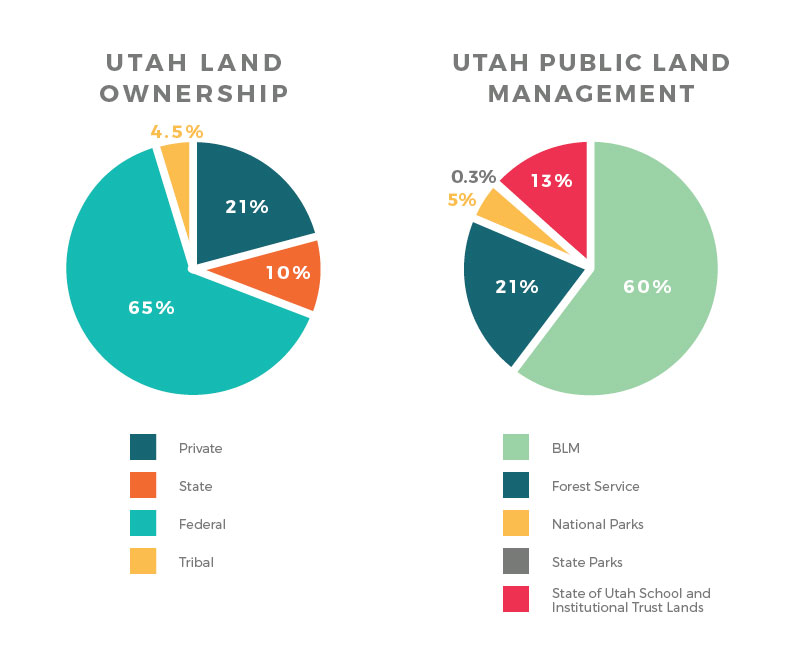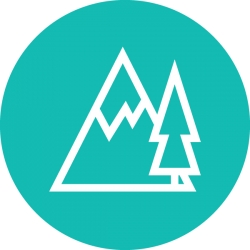Background:
Over 70% of Utah is public land owned by the federal or state government. This land is renowned for its natural beauty. There are many competing uses for these millions of acres, ranging from solar arrays, wind farms, and gas wells to habitat, grazing, watersheds, and recreation.
Utahns want to use public lands for a balance of various uses, while still remaining good stewards of the environment. With these vast areas of land, Utahns specifically want to maintain habitats, watersheds, and the natural beauty of the environment; provide recreation and opportunities to enjoy the outdoors with family and friends; and promote economic development through energy production, grazing, and tourism.
Utah’s public lands—from its red-rock deserts to its alpine mountaintops—have shaped cities, towns, and communities in many ways. Utahns have a variety of perspectives about the significance of these public lands. To Utah’s indigenous peoples, many of these lands are held sacred. To Utahns who descend from Mormon pioneers and early settlers, these lands provided a safe haven for their ancestors and created a culture, history, and economy unique to Utah. For many Utahns, these lands are a place to enjoy, recharge, and relax. And for others, they are the source of their livelihood and their ability to support their families. Much of the state’s watersheds and ecosystems are found on public lands. As the state grows, the choices Utahns make about how to manage these lands will influence the economy, quality of life, and identity of today’s residents and of future generations.
Public land is the land owned by the state or federal government. These lands make up more than 70% of Utah and include National Forests, Wilderness Areas, state and national parks and monuments, School and Institutional Trust Lands, lands managed by the Bureau of Land Management, etc.
Utah’s public lands have many purposes and uses that sometimes compete with one another. In the future, these uses will also be affected by the increased needs and demands of a growing population and rising numbers of tourists. How Utahns balance the many uses of public lands affects ecosystem health, recreation, water supply, energy production, agriculture, and Utah’s economy, particularly in the rural parts of the state.
BUREAU OF LAND MANAGEMENT (BLM)
Through the BLM, the federal government manages about 60% of the public lands in Utah. BLM lands are managed for multiple uses, ranging from recreation, habitat preservation, and wilderness to grazing, energy, and mining.
NATIONAL FORESTS
Through the U.S. Forest Service, the federal government manages about 21% of Utah’s public lands. Because the lumber industry in Utah has significantly declined, these areas are now mainly used for recreation and habitat preservation. National Forests are also used for limited amounts of mining, grazing, and energy development.
WILDERNESS AND PARKS
Approximately 12% of Utah’s public lands are Wilderness, Wilderness Study Areas, state parks, and national parks and monuments. These areas are largely managed to preserve natural character and for recreational use. Wilderness Areas—which can exist inside National Forests, monuments, or parks or on land managed by the BLM—have significantly more land-use restrictions than state or national parks. Wilderness Areas prohibit new roads and any vehicle traffic (including bicycles). Land-use restrictions in state and national parks vary.
SCHOOL AND INSTITUTIONAL TRUST LANDS
Almost 13% of Utah’s public lands are State of Utah School and Institutional Trust lands. When Utah became a state, Congress granted scattered parcels of land to Utah, from which revenue could be generated to support state institutions, including public schools, hospitals, teaching colleges, and universities. Today these lands generate revenue primarily for public schools as they are sold or leased for agriculture, grazing, mining, energy production, and other uses.
ENERGY DEVELOPMENT
Approximately 9% of Utah’s public lands are leased for energy development—almost all for oil and gas. Much of this acreage is not actively used to produce energy because the cost of extraction is too high or because lessees are holding out for a more favorable market. Oil and natural gas deposits are found in only a few portions of Utah, and most known reserves are already leased. In the future, there will likely be few additional areas leased for oil and gas development. The largest concentration of oil and gas leases in the state is in the Uintah Basin, with other small areas scattered throughout the state. Public lands are also increasingly being used to produce renewable energy like wind and solar power.



